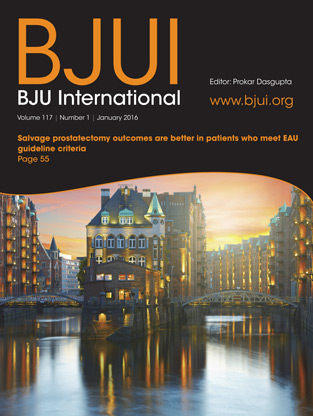The article by Borkowetz et al. [1], published in this issue, by a multi-disciplinary group from Dresden who have been offering MRI to their patients since 2012, would suggest so. In their hands, an image-guided biopsy resulted in 29 patients with Gleason scores of 7 or 8 being identified, who had been overlooked by an optimised 12-core systematic biopsy taken at the same sitting. Dedicating a minimum of two cores to a ‘target’ conferred an increase in detection of clinically significant prostate cancer, as defined by Gleason pattern ≥4, of 43% compared with systematic biopsy alone.
There is reason to think that, if anything, this might be an underestimate of the utility of sampling a target of high propensity for clinically significant prostate cancer vs a strategy that tries to spread the needle around the posterior limits of the gland. The reason for this is that the operator was aware of the location of the target during the systematic biopsy, as these were done after the targeted biopsy. The resulting incorporation bias should not trouble us too much, as its effect will be to make systematic biopsy ‘better’ and therefore diminish any difference between the two strategies. The fact that the patients had their systematic biopsy under anaesthesia and were in lithotomy (non-standard conditions) might add further to both bias and direction.
This study [1], like many before, incorporates a mixed population that comprises men who were biopsy-naïve (around one-quarter of the population) and those men who had undergone at least one previous biopsy. Again, this probably does not matter for our purposes, as the two groups were identical for overall cancer detection (52%) and very similar in terms of the proportion of patients with Gleason pattern ≥4 (80% for biopsy-naïve men vs 72% for those who had undergone a previous biopsy). The two groups had a similar number of lesions, around two lesions/subject were declared. The two groups did differ in PSA level; men undergoing repeat biopsy had a median PSA level twice that of men having a biopsy for the first time (12.2 vs 6.1 μg/L).
These results appear to be consistent with those summarised in a recent systematic review of studies that compared a targeted sampling strategy with another [2], but they do differ substantially from a recent study of >1000 biopsy-naïve men who were randomised to MRI vs a standard systematic TRUS biopsy approach [3]. In this large randomised controlled trial from Rome, the overall detection rate in MRI-positive individuals who underwent targeted sampling was 93% (410/440) vs the 52% (137/263) achieved in this study [1].
Both studies show higher detection rates compared with a standard systematic approach, and both show that targeting increases the proportion of men with clinically significant disease. However, exploring the differences between the studies might provide us with insight on how best to refine this new intervention. At present, the detection rate of clinically significant cancer (the generally agreed desired outcome of a biopsy when clinically significant disease is indeed present) is contingent on several variables [4]. They comprise the following: the population sampled; the target condition employed (definition of clinical significance); quality of the imaging; quality of the reporting; the threshold used for declaring a ‘lesion’ a target; the accuracy of the needle placement; the number of cores deployed to the target; and the efficiency of tissue capture. All these differed between the two studies, either explicitly or implicitly.
However, it is likely that the one with the greatest influence on the outcome is the level of certainty attributed to the lesion by the radiologist. There are several scales currently in use and this study used the Prostate Imaging Reporting and Data System (PI-RADS), which comprises an ordinal scale, range 1–5, derived from conditions being either met or unmet [5]. Ideally, a risk stratification system should influence clinical practice. A PI-RADS score of 1–2 should result in avoidance of a biopsy, because of the low probability of finding clinically significant disease. A PI-RADS score of 4–5 should result in a targeted biopsy, because of the high probability of underlying clinically significant disease. A PI-RADS 3 score should prompt a repeat assessment after a given interval, reflecting the indeterminate nature of the prediction.
In the study by Borkowetz et al. [1], PI-RADS scores of 2 and 3 were both associated with a 10% rate of Gleason pattern ≥4, suggesting poor discriminant ability between the two. On the other hand, PI-RADS scores of 4 and 5 were associated with a 24% and 60% detection rate, respectively, of Gleason pattern ≥4. From this we can say that lesions with PI-RADS scores of 4–5 should be targeted, are positively associated with risk, and will confer a high targeting yield. I think we can also say that more work is needed in relation to the inputs that generate PI-RADS 2–3 scores. This, fortunately, is in hand, as a new version of PI-RADS is soon to replace the one used in this article. Hopefully, it will improve the discriminant quality at the lower limits of PI-RADS and, as a result, should allow us to avoid incorporating a PI-RADS score of 2 into our targeting schedule.
Despite issues with the finessing of PI-RADS and other scoring systems, a task that will never be fully complete, this study adds to the burden of proof. What we can say, quite emphatically (based on this study, the systematic review and other studies published since), is that if patients want to maximise the chances of finding clinically significant prostate cancer, if it is indeed present, they should insist on an MRI before biopsy, so that targeting can be incorporated into the sampling strategy. To do otherwise would, according to this study, just about halve the chances of detecting clinically significant prostate cancer, if it were present.
Mark Emberton
UCL Division of Surgery and Interventional Science, UCL, London, UK
References
 Research headlines that attract the most publicity are those that show success in benefitting patients, whether it is through new targeted drugs or new immunotherapies. Many funding bodies and charities have also changed their policy toward funding more translational research that has clear economic, clinical and patient benefit. We must remember, however, that the innovations for these transformative publications and translational research projects are imbedded in our fundamental understanding of the molecular and cellular biology of disease investigated at the basic science level. These investigations are the cornerstone of translational research.
Research headlines that attract the most publicity are those that show success in benefitting patients, whether it is through new targeted drugs or new immunotherapies. Many funding bodies and charities have also changed their policy toward funding more translational research that has clear economic, clinical and patient benefit. We must remember, however, that the innovations for these transformative publications and translational research projects are imbedded in our fundamental understanding of the molecular and cellular biology of disease investigated at the basic science level. These investigations are the cornerstone of translational research.





